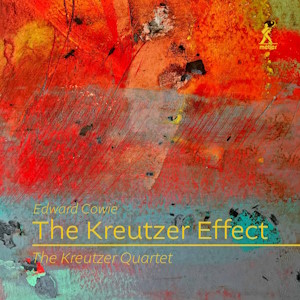
Edward Cowie (b. 1943)
The Kreutzer Effect
Glaukopis
Whatever happened to Icarus?
One Second Fiddle
Menurida Variants
String Quartet No.7 (“Western Australia”)
The Kreutzer Quartet
rec. 2022/2023, Hastoe Village Hall, Tring, UK
Métier MEX77103 [83]
Edward Cowie has had a long-running collaboration with the Kreutzer Quartet. Over the past decade, they have recorded his first six string quartets, and participated in several solo and duo works. Cowie wrote the seventh String Quartet with the talents of the Kreutzers in mind. He has also produced four portrait pieces, each dedicated to a member of the ensemble. They may have been composed around the same time as the Quartet, in 2017.
I acknowledge the extensive liner notes. I have mined them while preparing this review.
Glaukopis for solo cello is described as “Five Atmospheric Nocturnes for Athena”. The title derives from the Homeric name for the goddess of wisdom and war, Athene, but may also refer to the Greek phrase for owl-faced or owl-eyed. The suite “places five distinct species of European and British owls in their own typical dusk and nocturnal habitats. These may be dark and brooding woods; sparse and remote moorland; jade and black shaded conifer forest or the open pastures of farmland fields and meadows.”
The movements explore five bird species: little owl (Athene noctua), tawny owl (Strix aluco), short-eared owl (Asio flammeus), long-eared owl (Asio otus), and barn owl (Tyto alba). Cowie says: “All of these avian and mythological characteristics are evoked in this suite for cello.” These are not studies of birdsong, in the manner of Olivier Messiaen. They are intended to exploit the “colour and phrase” resources of the cello, which include a wide range of “dynamic and expressive techniques”. There are “screeches” which may be a direct representation of the owls’ voices. This ear-catching work successfully creates a numinous, nocturnal atmosphere.
The myth of Daedalus and Icarus – the imprisonment, the escape, the fall – may be interpreted as exploring the pitfalls of excessive ambition. Edward Cowie took it as the starting point for Whatever happened to Icarus?, an “aria for solo viola and about Global Warming”. The musical symbolism is obvious. From the lowest note a viola can play, the music climbs slowly ever higher by way of “a progress-by-variation”. The moral of the work is “that Icarus is the entire human race. In wishing to progress and rise, our species approaches a point of self-destruction-a world-once-noisy left without the ‘sounds of life.’” (Well, humankind might be able to get out of the mess by determination and ingenuity – if it so chose.)
If you like vocalisation, screams and mutterings, the metronome as a prop, and disjointed, hard-edged violin music, then One Second Fiddle is for you. I found it challenging, to say the least. Violinist Mihailo Trandafilovski surely gives it his best shot. The title refers to the fact that he plays second violin in the Kreutzer Quartet.
I found the Menurida Variants longwinded. At thirteen minutes, this solo violin piece demands more concentration than a listener may be prepared to commit to. Once again, there are vocal noises which add nothing to the sometimes beautiful violin melodies and passage work. This is based on Cowie’s response to the song of the Australian lyrebird. He wrote: “The sky was fast altering from jade shadows and indigo darkness into bronze and fiery copper and red dawn light. It was at this hinterland between night and day that a solitary Lyrebird began his grand cadenzas on the sonatas of the night. So magnificent; so complex; so virtuosic and rich was this song that I doubted I could ever compose something that would evoke (not imitate) the magic of that morning.” Whether he achieves this is up to the hearer to decide. I think he does, but with the above-mentioned caveats.
The String Quartet No.7 (“Western Australia”) was completed after what Cowie calls a “mind blowing three weeks exploring (north) Western Australia”. He was impressed by a constant flow of new life forms and vistas as he travelled. This suggested to him the “possibility of music that travels and mutates”. He then explains that the musical progress evolved in a continuous line, but “also of ‘places’ (musical passages), where it is necessary to stop and explore the intricacies and complexity of form at each pausing place”. This sense of forward momentum with pauses informs the first movement, The Road of Flowers. The middle movement, Hamelin Pool – Shark Bay, is a subtle balance between “movement and stasis”. It is a meditation on the acrobatic displays of birds, the “Blue on blue horizons” of the seascape, and the three-and-a-half-million-years-old algae found there. The music coruscates and sparkles, before dissolving into the ether.
The mysterious Pinnacles of Nambung National Park inform the final movement. (Look them up: they are amazing.) The site was sacred to the Aboriginal community. Cowie considers the multitude of shapes apparent in these natural sculptures. The music reflects these ever-evolving shapes. The movement ends in a shimmer of light before dying to ‘niente’.
Edward Cowie wrote the thorough liner notes, with additional material by members of the Quartet. There are the usual biographical details of all concerned. The booklet is illustrated with photographs of the recording session, the composer and the quartet. Heather Cowie created the evocative cover painting. The recording is splendid, and the performances are clearly formidable.
I did not enjoy On Second Fiddle and the Menurida Variants. I was impressed with Icarus and Glaukopis. But the highlight is the String Quartet, a dazzling, often moving portrayal of “the ever-changing landscapes and intricate ecosystems of Western Australia, inviting listeners on a transformative journey through time and space”.
John France
To gain a 10% discount, use the link below & the code musicweb10

The Kreutzer Quartet
Peter Sheppard Skærved (violin), Mihailo Trandafilovski (violin), Clifton Harrison (viola), Neil Heyde (cello)


















